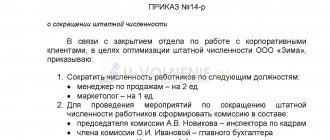Home / Dismissal and layoffs / Dismissal according to the Labor Code - how many months in advance do they warn an employee about layoffs?
Every employer should remember that staff reductions must be carried out in strict accordance with the requirements established by labor law. One of these rules is the mandatory notification of the employee about dismissal. How long does it take to notify? How to do this correctly? The answers to these questions can be found in this article.
Grounds for dismissal and employee guarantees
The Labor Code of the Russian Federation provides an extensive list of reasons why an employment contract may be terminated. The grounds for dismissal at the request of the employer include (Article 81):
- Termination of activities of a business entity or individual entrepreneur;
- Reduction of personnel (numbers or staff);
- If the employee “failed” the certification (the basis will be a discrepancy with the position he occupies);
- Systematic evasion from performing one's job functions;
- Gross violation of labor discipline (even if committed once). This includes absenteeism, drunkenness at work, drug use, etc.;
- If the employee made a decision that led to damage to the employer (applies to management positions), etc.
General information about laying off an employee is described in this article.
An employee whose employment contract was terminated due to layoffs has the right to receive the following guarantees (Chapter 27 of the Labor Code of the Russian Federation):
- Payment of severance pay;
- Preferential right to remain at work (if such personnel have high qualifications and performance indicators);
- Choose another vacant position proposed by the organization’s management;
- Receive notice of dismissal in advance (how long before an employee is notified of layoffs will be indicated below);
- Leave a position that has been laid off early.
Do you have a question about the notice period for layoffs?
Ask an experienced employment lawyer as part of FREE consultation!
Hotline in Moscow: 8 (495) 131-95-79
Ask a Question
THE PREFERENCE RIGHT TO REMAIN AT WORK DOES NOT TAKE CONSIDERATION
You may encounter such a problem during downsizing if there are several positions of the same name in the staffing table. For example, a department has three sales managers, but only one needs to be laid off. In this case, part one of Art. 179 of the Labor Code of the Russian Federation requires that the employer, when laying off workers, retains workers with higher labor productivity and qualifications.
Qualifications can be verified using an education document and work record, but assessing labor productivity will require some effort from the employer.
- How to evaluate labor productivity? It is not difficult to assess the productivity of working personnel - it is enough to find out whether employees comply with labor standards (time and output). The situation with assessing the productivity of knowledge workers is much more complicated. Here are some tips:
1. If the organization conducts an annual personnel assessment, we recommend attaching its results. The results of the certification, if any, will also be useful.
2. If the organization has established bonus indicators, the productivity of employees can be assessed by the size and frequency of bonuses awarded to them. You can also take into account the regular performance of additional work (for example, part-time or by special order). We recommend assessing the employee’s work discipline. If discipline is low or there are comments or reprimands, then such an employee does not have a preemptive right.
- How to Document Performance Evaluations. The first step is to issue an order to create a commission to determine the preferential right to remain at work. The order must contain the following provisions:
Read more: Sample complaint about lack of heating in the apartment
The results of the assessment must be indicated in the minutes of the meeting of the special commission. In court, the protocol is evidence that the employer took into account the preferential rights of employees. The protocol should be accompanied by tables assessing the employees’ compliance with production or service standards, plans, instructions, etc. (see table).
If labor productivity and qualifications of workers in identical positions are approximately equal, you should go further and give preferential rights to the following categories (part two of Article 179 of the Labor Code of the Russian Federation):
•family with two or more dependents;
•persons whose family does not have working family members;
•workers who, while working in the organization, received a work injury or occupational disease;
•disabled people of WWII and combat;
•workers who improve their skills without interruption from work in the direction of the employer;
•other categories of employees in accordance with the collective agreement.
Supporting documents should be requested from such employees. For example, an employee with two or more children must provide birth certificates, as well as a passport with registration confirming residence with children; combat disabled person - certificate.

How should notification be given?
As noted above, management is required to notify its employees in advance of upcoming changes. In this case, the preparation of the notice is carried out according to the following rules:
- The notice is sent to each employee personally.
- The document must be signed by the recipient.
- Strict adherence to the deadline set aside by law for this procedure.
There is no single template for notice of staff reduction. In most cases, organizations independently approve the form of such paper. However, it must contain the details of the relevant order, a list of positions to be abolished, as well as the exact date of this event. In addition, you can also immediately mark a list of available jobs here.
There are several ways to send notice of staff reduction.
It can be transmitted through personal contact - this option is used if the recipient is present at work. In addition, the employee can be called (if he is on vacation, sick leave, etc.) and asked to review the document.
Send by registered mail or courier - this is done if it is not possible to deliver the paper in person. Using this option, you should be concerned about receiving a document confirming delivery of the notice to the addressee.
You may find the following information interesting: notice of staff reduction (sample).
If an employee refuses to read the notice of staff reduction and also to put his signature on it, then a special act should be drawn up. Moreover, this must be done in the presence of two witnesses. This document reflects the following information:
- The date and place where the employee was made aware of the layoff notice.
- Full name and position of the persons present during this procedure.
- Information about the offender himself, as well as notification details.
- Rejection reason.
At the end of the act there must be signatures of witnesses, as well as the person who compiled this paper.
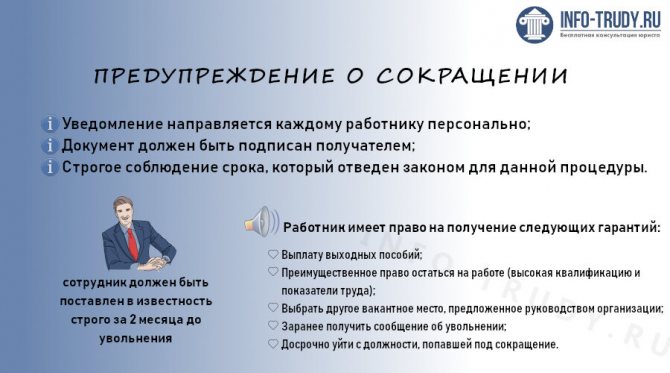
Notice period for upcoming layoffs
So, how long before an employee is given notice of layoff? In Part 2 of Art. 180 of the Labor Code of the Russian Federation there is a rule indicating that an employee must be notified strictly 2 months before dismissal , which will be made as a result of a reduction in staffing units or personnel.
The employer must remember that a written warning must be sent to the trade union and the employment service at the same time. If the reduction is massive, then this must be done 3 months before the upcoming changes.
The Supreme Court clarified the responsibilities of the employer during layoffs
Vitaly Aksenov* held various positions at the Mining and Chemical Combine, owned by the Rosatom state corporation, for almost 29 years (from 1990 to 2019), and since 2021 has been a milling operator. In October 2018, he received notice of the upcoming layoff. He was fired on January 10, 2021. Aksenov considered that the employer’s actions were illegal, since he was not offered a different rate. Therefore, the plant employee went to court.
Decisions in favor of the employer
Aksenov stated in court that the enterprise had such available vacancies as a special train operator, an office inspector, a baker, a bus driver, and a storekeeper. The employer offered these positions to other laid-off employees, but did not give the plaintiff any alternative. The former employee considered that the plant had violated his rights and asked the court to reinstate him as a milling machine operator, to recover from the Mining and Chemical Plant the average salary for the period of forced absence (almost 230,000 rubles), and compensation for moral damages (100,000 rubles).
Company versus employee: problems with dismissal and more
A representative of the plant objected that there were no violations. They decided to transfer the tasks performed by milling operators to third-party specialized organizations. The general director believed that this would increase work efficiency. The plant offered all the rates available at that time to other employees, and they agreed. There was no free place for Aksenov, so he was not offered an option for his position. The employer decides which of the dismissed employees will offer a vacant position, since this procedure is not regulated by law, a representative of the enterprise indicated.
The first instance agreed with the defendant. The court indicated: according to Art. 81 of the Labor Code (“Termination of an employment contract at the initiative of the employer”), an employee can be laid off if he cannot be transferred to another position. Resolution of the Plenum of the Supreme Court dated March 17, 2004 No. 2 “On the application of the Labor Code by courts” allows dismissal due to reduction if a person did not have a preferential right to remain at work and was warned about dismissal two months in advance (part 2, paragraph 29). The Zheleznogorsk City Court of the Krasnoyarsk Territory indicated that Aksenov knew in advance about the termination of the employment contract, because the notice contained his signature. And there was no ban on dismissal, as well as other vacant positions. Therefore, the court rejected Aksenov’s claim (case No. 2-736/2019). The appeal and cassation turned out to be of the same opinion. Then the plaintiff complained to the Supreme Court.
Not a right, but a duty
The case was considered by a trio of judges chaired by Svetlana Frolkina. As the Supreme Court decided, Art. 180 of the Labor Code (“Guarantees and compensation to employees in the event of liquidation of an organization, reduction of the number or staff of an organization’s employees”) obliges, in the event of a reduction, to offer the employee another position. This is a guarantee against arbitrary dismissal of specialists. At the same time, the employer must find alternative rates for all dismissed specialists. And they will already decide whether to agree or not. The trio of judges decided: the lower authorities unlawfully agreed with the defendant’s arguments that the employer himself decides which of the dismissed employees will be offered open vacancies.
To offer an employee all available vacant positions during layoffs is not the employer’s right, but his responsibility, the Supreme Court noted.
According to the panel, the dispute should have established whether, from the moment of notification until the day of Aksenov’s dismissal, there were vacancies that would correspond to his qualifications, or lower positions with a lower salary. The Supreme Court also pointed out that the courts did not give a legal assessment to the order of the general director to reduce staff. Therefore, the conclusions of the lower authorities about the legality of the plaintiff’s dismissal are erroneous, the judges decided and sent the case to the first instance. The dispute has not yet been considered (case No. 53-KG20-4-K8).
“The definition of the Armed Forces forces us to reconsider the approach to staff reduction,” says Anna Ivanova, head of the labor law practice at Egorov, Puginsky, Afanasyev and Partners Federal Rating. group Antitrust law (including disputes) group Arbitration proceedings (major disputes - high market) group Compliance group Corporate law/Mergers and acquisitions group International litigation group International arbitration group Maritime law group Dispute resolution in courts of general jurisdiction group Capital markets group Family and inheritance law group Insurance law group Labor and migration law (including disputes) group Criminal law group Private capital management group Pharmaceuticals and healthcare group Financial/Banking law group Environmental law group Bankruptcy (including disputes) group Foreign trade activities/Customs law and currency regulation group PPP/Infrastructure projects group Land law/Commercial real estate/Construction group Intellectual property (including disputes) group Tax consulting and disputes (Tax consulting) group Tax consulting and disputes (Tax disputes) group Natural resources/Energy group TMT (telecommunications, media and technology) group Transport law group Digital Economy 1st place By revenue 1st place By revenue per lawyer (more than 30 lawyers) 1st place By number of lawyers Company profile. According to her, previously the courts took the opposite position. For example, the Volgograd Regional Court in case No. 33-8366/2020 or the Smolensk Regional Court in case No. 33-3851/2012.

The SC believes that all employees should receive notice of vacancies in the company. But what to do if there is only one position, but there are several employees being laid off? It would be worse for the employer to offer one position to everyone, get consent, and hire someone at their own discretion.
Anna Ivanova, head of labor law practice at AB Egorov, Puginsky, Afanasyev and partners Egorov, Puginsky, Afanasyev and partners Federal rating. group Antitrust law (including disputes) group Arbitration proceedings (major disputes - high market) group Compliance group Corporate law/Mergers and acquisitions group International litigation group International arbitration group Maritime law group Dispute resolution in courts of general jurisdiction group Capital markets group Family and inheritance law group Insurance law group Labor and migration law (including disputes) group Criminal law group Private capital management group Pharmaceuticals and healthcare group Financial/Banking law group Environmental law group Bankruptcy (including disputes) group Foreign trade activities/Customs law and currency regulation group PPP/Infrastructure projects group Land law/Commercial real estate/Construction group Intellectual property (including disputes) group Tax consulting and disputes (Tax consulting) group Tax consulting and disputes (Tax disputes) group Natural resources/Energy group TMT (telecommunications, media and technology) group Transport law group Digital Economy 1st place By revenue 1st place By revenue per lawyer (more than 30 lawyers) 1st place By number of lawyers Company profile
This is what happened with the employee who was reinstated this summer, Ivanova continues. The Sverdlovsk Regional Court motivated this by the fact that the employee had written consent to fill the vacant position. That is, the employer has an obligation to transfer him to one of the specified rates (case No. 33-8854/2020).
To avoid problems with unsuitable employees, before layoffs, you can remove all vacant positions from the staffing table and establish a complete ban on new hiring for two or three months (during the downsizing period), advises Ivanova. She also recommends removing all job advertisements from the official website and from recruitment agencies. If you need to hire someone and there is no way to wait a quarter, then Ivanova advises to write down such qualification requirements in the job description that will not suit any of the laid-off workers.
*– first and last names have been changed by the editors.
- Sinchenkova Anastasia
- Supreme Court of the Russian Federation
- Civil process
Employer's liability for violation of rules
The staff reduction procedure must be carried out in full accordance with the procedure established by the Labor Code of the Russian Federation. Failure to comply with at least one of the conditions is a violation of labor law, for which the employer may be held administratively liable (in special cases, even a criminal case may be opened).
An important point is how long the employee was warned about the layoff. If the management of the organization ignored the period allotted by law for this procedure, then such an act is an administrative offense, for which punishment is provided in the form of a warning or a fine, the amount of which is (Clause 1 of Article 5.27 of the Code of Administrative Offenses of the Russian Federation):
- 1-5 thousand rubles (for officials and individual entrepreneurs);
- 30-50 thousand rubles (for legal entities).
In addition, the dismissed person can file a claim against the employer who committed the violation. If the court finds such a reduction illegal, then the plaintiff will be able to easily return to his previous position.
PERSONNEL DOCUMENTS ARE COMPLETED WITH ERRORS
Errors in the preparation of personnel documents can lead to fines and even reinstatement of the employee. To avoid them, you need to carefully formalize his dismissal on the last day of work (paragraph two of the first part of Article 84.1 of the Labor Code of the Russian Federation, clause 35 of the Decree of the Government of the Russian Federation of April 16, 2003 No. 225).
Below we list the actions of the employer on the last working day of the dismissed employee.
- We issue a dismissal order. The order is drawn up according to the unified form No. T-8 or No. T-8a [1] or according to the form approved by the organization (Example 7). If the order is drawn up later than the day of dismissal, in a controversial situation the court will declare it invalid.

The employee must be familiarized with the order against signature. If you refuse to familiarize yourself, you must draw up a corresponding act, which must be signed by two or three employees (Example 8).
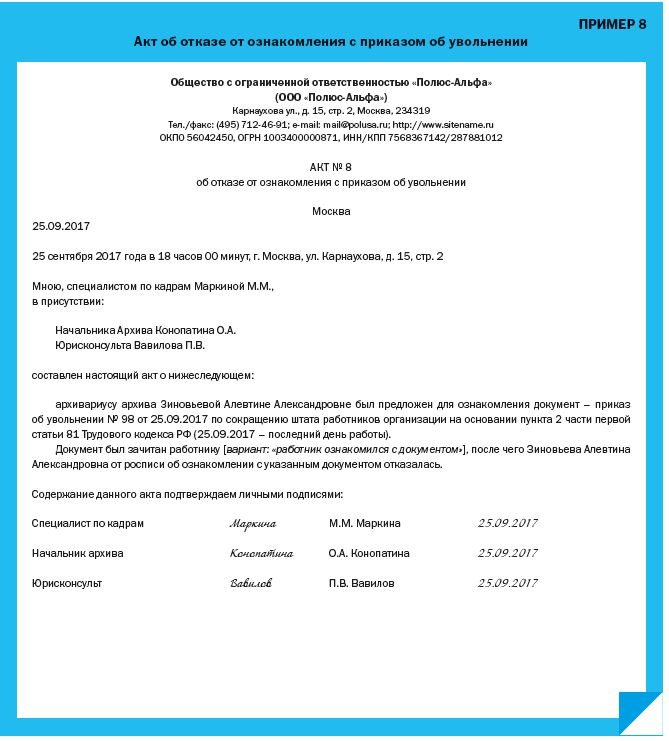
- We draw up a note-calculation. The calculation note is a mandatory document for publication and is sent to the accounting department on the day the employee is dismissed. It is drawn up either according to the unified form No. T-61 or according to the form approved by the organization. In it, the personnel officer reflects the number of days of unused or advance-used vacation (Example 9).
- We make an entry in our personal card. An entry about the dismissal of an employee must be made in section XI of the personal card of Form No. T-2, which the employee must be familiarized with against signature (Example 10).
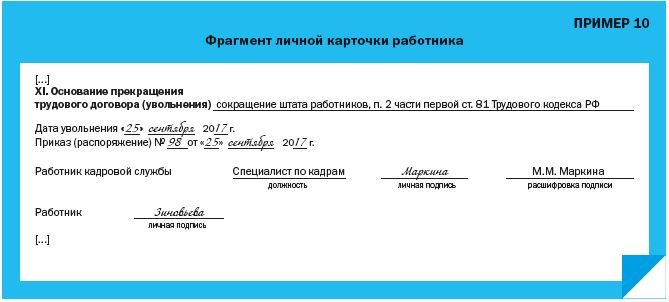
- We issue a work book. On the day of dismissal, the employee must be given a work book with a record of dismissal (Article 84.1 of the Labor Code of the Russian Federation) against signature in the work record book (Example 11).

If an employee refuses to receive a work book, a statement about this must be drawn up signed by two or three employees (Example 12).
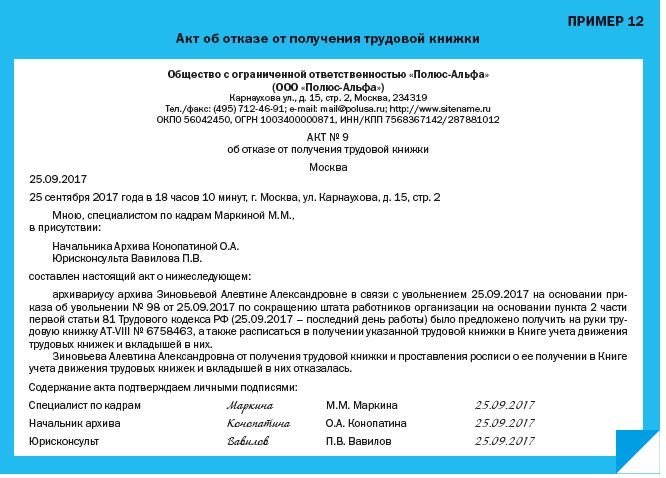
If the employee does not show up to pick up the work book, you must send him a notice before the end of the working day about the need to pick up the work book (Example 13) or give written consent in any form to send it by mail (part six of Article 84.1 of the Labor Code of the Russian Federation). It is better to send the notice to all known addresses of the employee to increase the likelihood of receiving it.
- We issue certificates. Upon dismissal, the employer is also obliged to provide the employee with:
•a certificate of the amount of his earnings, on which insurance contributions to the Social Insurance Fund were calculated (Part 2 of Article 4.1 of the Federal Law of December 29, 2006 No. 255-FZ “On Compulsory Social Insurance in Case of Temporary Disability and in Connection with Maternity”[2 ]);
•a certificate with information on accrued and paid insurance contributions to the Pension Fund of the Russian Federation (Article 11 of the Federal Law of April 1, 1996 No. 27-FZ “On individual (personalized) accounting in the compulsory pension insurance system” [3]).




